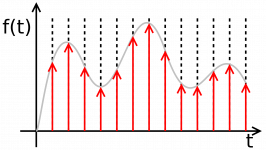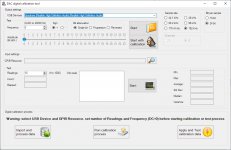Keithley 2001, 7 1/2 digits DMM
Absolute accuracy does not matter, what matters is the stability during the measurement since we are talking of ratio between each measurement (relative and not absolute).
The checked deviation of the tool offset when measuring DC is less than 200nV a hour, less than the LSB of the DAC.
Absolute accuracy does not matter, what matters is the stability during the measurement since we are talking of ratio between each measurement (relative and not absolute).
The checked deviation of the tool offset when measuring DC is less than 200nV a hour, less than the LSB of the DAC.
This is very strange to me, maybe the designer could explain where I'm wrong.
What are you actually hoping to achieve with all this? You clearly have an agenda, so why don't you just come out and say it.
Keithley 2001, 7 1/2 digits DMM
Absolute accuracy does not matter, what matters is the stability during the measurement since we are talking of ratio between each measurement (relative and not absolute).
It absolutely pains me to link it, but some measurements posted on ASR have the dam1021 producing accuracy down to at least 17 bits with sine waves, and that is a 0.05% board.
What I don't understand, is why do you feel you need to screw around with filters so badly, just to test with DC, when that is completely unrepresentative of music?
What I actually hoping to achieve?
I thought it was enough clear, I'm testing a system to calibrate R2R DACs.
My DAM1021 is a R2R DAC, is this a problem for you?
DC is completely unrepresentative of music, are you sure?
So the red lines in the attached picture are not DC?
However I have performed the measurement even in AC and the result is the same.
Only my DMM is a little less accurate in AC.
Then, if you know how a R2R DAC works, it should be clear for you that the best way to calbrate its precision is measuring the contribution of each resistor of the ladder network to the output voltage.
Is this clear?
Finally, 17 bit it's not impossible, around 10% of the production statistically will provide 17 bit.
Let me repost the statistical analisys performed by ScreamingLordByron (link already provided):
100% can deliver 12-bit performance
94.2% can deliver 14-bit performance
30.8% can deliver 16-bit performance
8.6% can deliver 18-bit performance
1.8% can deliver 20-bit performance.
Clear?
I thought it was enough clear, I'm testing a system to calibrate R2R DACs.
My DAM1021 is a R2R DAC, is this a problem for you?
DC is completely unrepresentative of music, are you sure?
So the red lines in the attached picture are not DC?
However I have performed the measurement even in AC and the result is the same.
Only my DMM is a little less accurate in AC.
Then, if you know how a R2R DAC works, it should be clear for you that the best way to calbrate its precision is measuring the contribution of each resistor of the ladder network to the output voltage.
Is this clear?
Finally, 17 bit it's not impossible, around 10% of the production statistically will provide 17 bit.
Let me repost the statistical analisys performed by ScreamingLordByron (link already provided):
100% can deliver 12-bit performance
94.2% can deliver 14-bit performance
30.8% can deliver 16-bit performance
8.6% can deliver 18-bit performance
1.8% can deliver 20-bit performance.
Clear?
Attachments
What are you actually hoping to achieve with all this? You clearly have an agenda, so why don't you just come out and say it.
BINGO! And the agenda is: "find something wrong with our competitor product, so that we can eventually claim "ours is longer than yours".
Last edited:
BINGO! And the agenda is: "find something wrong with our competitor product, so that we can eventually claim "ours is longer than yours".
I was worried you hadn't posted a comment yet.
So you are usually measurements obsessed but right now you are against?
This is enough curious.
And what is our competitor product?
Maybe this?
But it's software only!
And it will be released for free.
Attachments
Last edited:
What I actually hoping to achieve?
...
Clear?
Not really, no. Soekris dac1421 measured down to 20 bits of accuracy here: Review and Measurements of Soekris dac1421 Multibit DAC | Audio Science Review (ASR) Forum
Your DC approach with a multimeter is clearly not even close to being accurate enough.
But don't worry, I'm sure Soekris will be along soon to help you out.
And what is our competitor product?
<snip>
And it will be released for free.
I thought the Soekris DACs?
Free as in no schematics, no source code, no FPGA configuration. Whih makes it as free as my Samsung TV.
But don't worry, I'm sure Soekris will be along soon to help you out.
I hope not.
I don't think you will get any better accuracy. I also did some measurements with the 74lvc595 a while back. Apart from the fact that the output resistances of each output are not identical and differ at 0 and 1, they also change depending on how many bits are switched on.The accuracy improves up to 17-18 bit but not up to 22-23 bit as expected in the grid named "Expected fine calibration", which would need the measurement of the contribution of each resistor in the ladder to the output voltage.
I believe this would be possible if I found the way to get the DAC playing bit perfect, but I am not able to succed unless the designer will help.
So don't expect too much.
Andrea, what do you think the accuracy and symmetry of your Dac looks like when you feed it with 2 unregulated battery sources?
Not really, no. Soekris dac1421 measured down to 20 bits of accuracy here: Review and Measurements of Soekris dac1421 Multibit DAC | Audio Science Review (ASR) Forum
Your DC approach with a multimeter is clearly not even close to being accurate enough.
But don't worry, I'm sure Soekris will be along soon to help you out.
Really?
Please, explain why DC approach with a multimeter is not accurate.
I'm happy to learn.
And please, try to understand that 0.006% THD (as in the review you have linked) means 14 bit accuracy since 0.006% THD means 84dB, which just means 14 bit precision: 14 x 6 = 84.
I thought the Soekris DACs?
Free as in no schematics, no source code, no FPGA configuration. Whih makes it as free as my Samsung TV.
I hope not.
Maybe you have not understood, I meant the DAC digital calibration tool I'm testing.
It's just software and I will release the application for free.
I don't think you will get any better accuracy. I also did some measurements with the 74lvc595 a while back. Apart from the fact that the output resistances of each output are not identical and differ at 0 and 1, they also change depending on how many bits are switched on.
So don't expect too much.
Andrea, what do you think the accuracy and symmetry of your Dac looks like when you feed it with 2 unregulated battery sources?
The goal of the calibration is just to correct the nonlinearity of the switches and the resistors in the ladder of the DAC.
I believe I would get better accuracy if I succeeded measuring the error of each single bit (switch + resistor) but unfortunately I have not found the way to get my DAM1021 playing bit perfect.
We have not yet decided how to power the analog section of our DAC.
We will try unregulated LTO batteries measuring the accuracy.
If it is not satisfactory we will probably add a tracking regulator.
Maybe you have not understood, I meant the DAC digital calibration tool I'm testing.
It's just software and I will release the application for free.
And no source code. Which will make it proprietary for your "DIY" DAC, nice try.
And no source code. Which will make it proprietary for your "DIY" DAC, nice try.
You are wrong, I will also release the dotnet source code.
The Windows application will be in public domain so everyone can adapt it to their DMM and USB to I2S source.
The application contains the algorithm to apply the calibration, so everyone can code his DSP to manage whatever DAC you want.
The algorithm could be even applied in software writing a suitable audio player wich implements it.
I have used Naudio library and it's very powerful.
I will not write the audio player.
But of course no support, I have not enough free time.
Last edited:
Really?
Please, explain why DC approach with a multimeter is not accurate.
Because you aren't getting accurate data, clearly.
Audio DACs aren't built to pass DC. The digital filters aren't designed for it, and I'd bet the Vrefs aren't designed for it. You can put up all the figures you like, but an FFT of real music will have nothing at zero Hz.
And please, try to understand that 0.006% THD (as in the review you have linked) means 14 bit accuracy since 0.006% THD means 84dB, which just means 14 bit precision: 14 x 6 = 84.
And yet input vs output matches to 0.5 dB down to 20 bits. Could you possibly be looking at the problem wrong? Surely not!
I'm happy to learn.
No you're not. There's years of evidence in this thread against that notion.
Last edited:
You are wrong, I will also release the dotnet source code.
The Windows application will be in public domain so everyone can adapt it to their DMM and USB to I2S source.
The application contains the algorithm to apply the calibration, so everyone can code his DSP to manage whatever DAC you want.
The algorithm could be even applied in software writing a suitable audio player wich implements it.
I have used Naudio library and it's very powerful.
I will not write the audio player.
But of course no support, I have not enough free time.
Ok, can't wait to see this. Do you have a github, bitbucket, etc... tree to share?
Because you aren't getting accurate data, clearly.
Audio DACs aren't built to pass DC. The digital filters aren't designed for it, and I'd bet the Vrefs aren't designed for it. You can put up all the figures you like, but an FFT of real music will have nothing at zero Hz.
And yet input vs output matches to 0.5 dB down to 20 bits. Could you possibly be looking at the problem wrong? Surely not!
No you're not. There's years of evidence in this thread against that notion.
I give up, it's clear you dont know how a R2R DAC works.
I hoped the picture in post #10425 would help to understand how a DAC works.
No way.
I give up, it's clear you dont know how a R2R DAC works.
I hoped the picture in post #10425 would help to understand how a DAC works.
No way.
You are doing a great job of being "happy to learn". I wish you the best of luck with your future endeavours. And learning how to use a serial port. And all the other things you can't seem to get working.
Ok, can't wait to see this. Do you have a github, bitbucket, etc... tree to share?
Not yet, I will provide.
For now the application is still under test but unfortunately my DAM1021 does not help because I have not yet found the way to get it playing bit perfect.
I send a word to the DAC but it plays a different one.
Last edited:
- Home
- Vendor's Bazaar
- Reference DAC Module - Discrete R-2R Sign Magnitude 24 bit 384 KHz

